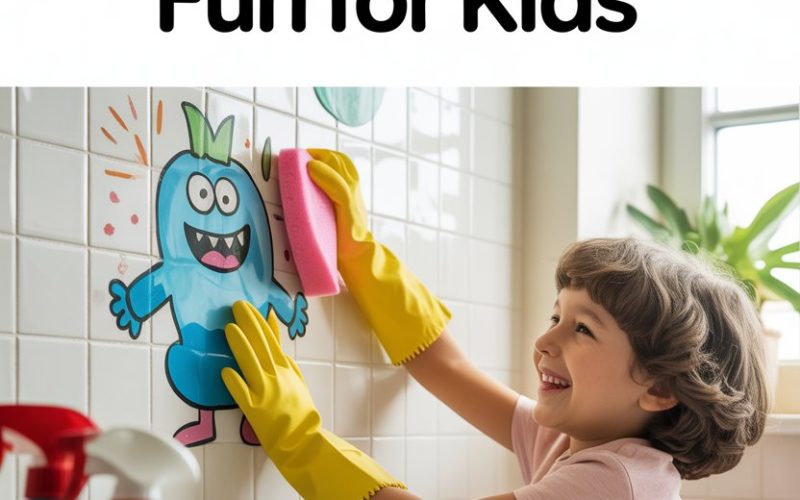Kids and cleaning: the ultimate odd couple.
If your child practically turns to stone when handed a broom, or you’ve ever found a soggy sock stuffed behind the sofa during a “family tidy-up,” you’re not alone.
But cleaning doesn’t have to be a battle of wills or a test of your patience.
With a dash of creativity (and a sprinkle of humour), tidying up can actually become one of those rare household activities that doesn’t make everyone want to hide in the loo.
Here’s how to turn the daily grind into a game everyone wants to play.
1. Turn Cleaning into a Race
Kids love competition—especially when they think they might win against you. Set a timer and challenge them to see who can finish their task the quickest.
Use a kitchen timer, your phone, or an app with fun sound effects for extra motivation. The sight of your child frantically throwing books onto a shelf to “beat mum” is oddly satisfying.
Stagger the races: one for picking up toys, another for dusting, another for matching clean socks (good luck). And yes, let them win sometimes.
According to research on gamification and motivation, turning chores into games increases engagement and actually helps kids stick with the activity longer. Plus, you’ll have a sparkling living room in record time—at least until snack crumbs strike again.
2. Assign Silly Roles and Personas
Why have a cleaner when you could have a “Robot 3000,” a “Sock Detective,” or “The Great Dustinator”? Let your kids pick their own cleaning alter-ego, complete with a silly hat or homemade badge.
Suddenly, wiping the table isn’t a bore—it’s a mission for Agent Crumb-Buster.
Personas not only fuel imaginations, but also create emotional distance from the “chore” side of things. If your child is playing, they’re less likely to resist (and more likely to ask if they can be the Vacuum Wizard again tomorrow).
3. Create a Special Cleaning Playlist
There’s a reason so many cleaning montages in films involve upbeat music. Make a “clean-up” playlist with your kids’ favourite songs.
Let them choose the starting track, then challenge them to finish their task before the third song ends. Extra points for interpretive dance moves with their feather duster.
Music has been shown to boost mood and productivity—and yes, that applies to kids too. Whether you’re into Taylor Swift or the soundtrack from Bluey, crank it up and let the tunes do half your work.
4. Introduce a Reward System (with a Twist)
Everyone loves a reward chart, but why not jazz it up? Each time a cleaning job is complete, let your child add a silly sticker to a board, or pop a colourful ping pong ball into a “cleaning jar.”
Once the jar’s full, the family earns a reward: a movie night, pancakes for dinner, or an hour where socks can be flung with abandon (within reason).
The key: keep the rewards quick and achievable. Psychologists have found that immediate, tangible rewards work best for younger kids.
If you accidentally invent a lifelong obsession with gold star stickers, well, that’s just a risk you’ll have to take.
5. Make It a Scavenger Hunt
Nothing grabs a child’s attention like the promise of hidden treasure. Hide small “prizes” (think: a tiny dinosaur, a jelly bean, or a note with a dad joke) under clutter, cushions, or laundry piles.
The only way to find them? Tidy up those areas.
This works wonders for little ones who’d rather play than clean. And for older kids, turn up the challenge: create clues or riddles that lead them from one messy zone to the next.
Who knew finding a half-eaten rice cake under the bed could be so thrilling?
6. Use Kid-Sized Tools
Ever seen a child try to mop the floor with a stick twice their height? It’s like watching a cat ride a unicycle.
Invest in child-friendly cleaning supplies: a mini dustpan, a lightweight broom, or a spray bottle filled with water (no harsh chemicals, please).
Let them pick the colour or decorate their gear with stickers. Having their own tools not only makes the job easier, but also gives them a sense of ownership.
As child development experts point out, kids are more likely to pitch in when the task feels achievable and the equipment fits their little hands.
7. Invent Cleaning Challenges
Challenge your kids to clean “all the things that are blue,” or “everything that makes a funny noise when you shake it.” Set up a “Sock Sorting Olympics,” where everyone tries to match the most pairs in two minutes.
These challenges add novelty and keep things fresh.
If you’re feeling brave, invite their mates around for a “cleaning party” (with a handshake agreement that parents return the favour at their house next time). It’s chaos, but it works.
8. Set Up Visual Progress Trackers
Kids love to see their progress—preferably in bright colours. Make a simple chart or fill a jar with marbles as each task is completed.
Or take before-and-after photos of rooms; nothing beats seeing the transformation (and possibly showing off to Grandma later).
According to parenting researchers, visual cues are especially helpful for younger children, who thrive on concrete feedback. Plus, you’re building skills that’ll come in handy long after the glitter glue and LEGO have moved out.
9. Make Cleaning Social (Yes, Really)
Everything’s better with company. Tidy up together and use the time to catch up—what happened at school, who painted the cat blue, why the goldfish seems traumatised.
For kids who crave connection, cleaning can become a bonding moment rather than a punishment.
Research suggests that family chores strengthen relationships, and kids are more likely to do their bit if they feel they’re part of a team.
You’re not just dusting; you’re building trust, and probably a few inside jokes about the weirdest thing found in the toy box this week.
10. Lean Into the Absurd
Sometimes all it takes is a little ridiculousness. Hold a “backwards cleaning day,” where everyone wears their clothes backwards while tidying.
Or have a “no-hands tidy-up,” challenging everyone to pick up toys with their elbows or feet. (Fair warning: breakables may want to sit this one out.)
The point isn’t perfection. It’s about making memories and shifting the vibe from “ugh” to “this might actually be fun.”
When kids associate cleaning with laughter and silliness, they’re far more likely to pitch in without fuss next time.
Turning Cleaning into Connection
If you’ve ever wanted to banish the phrase “I’ll do it later” from your home, a bit of playfulness might be your secret weapon.
Tidying up will never be your children’s favourite pastime (and if it is, please share your secrets), but with a few tricks up your sleeve, you can turn chore time into laugh-out-loud family time.
You’re not just raising tidy kids—you’re raising creative problem-solvers who know how to make the best of even the dullest jobs.
And if that means your hallway occasionally echoes with the phrase “Robot 3000 needs more glitter!”—well, wouldn’t life be boring otherwise?





